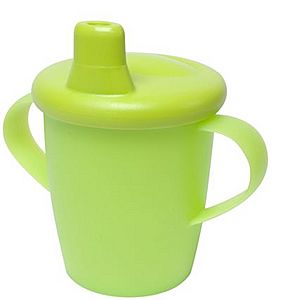Sippy cup facts for kids
The sippy cup, also called a training cup in America or a beaker in Britain, is a special drinking cup. It's made for young children, usually toddlers, to help them drink without spilling. Unlike a regular open cup, a sippy cup has a lid that stops liquid from coming out easily. Children drink from it using a spout or a straw.
Some sippy cups have clever designs that use how liquids stick together (called surface tension) to stop spills, even if the cup tips over. Others have special valves that open only when a child drinks. Sippy cups are often used as a step between drinking from a baby bottle or breastfeeding and using a regular open cup. However, some experts suggest going straight from a bottle or breast to an open cup.
Contents
Who Invented the Sippy Cup?
The first spill-proof sippy cup, called the Sipster, was invented by a man named Richard Belanger. He later allowed the company Playtex to use his design.
Belanger created his version of the sippy cup in the 1980s. He was tired of cleaning up drinks his son spilled. As a mechanical engineer, he knew how nozzles worked, like those on hot glue guns. He decided to solve the problem himself.
He made a first version using parts from Tupperware containers and a special mouthpiece. After trying different mouthpieces, he finally created what we now know as the sippy cup. For a few years before Playtex used his design, Belanger and his family sold sippy cups directly from their home to friends and family.
How Are Sippy Cups Used?
Sippy cups help young children learn to drink from a regular cup without a lid. While these cups are great at preventing spills, many dentists and health experts agree on one thing. Using a sippy cup for too long can cause tooth decay in children, especially those under six years old.
Different Kinds of Sippy Cups
Today's sippy cups are a bit different from Richard Belanger's first design. They come with various types of spouts:
- Hard Spouts: These spouts are made from strong, hard plastic.
- Soft Spouts: These are made from softer plastic, often silicone.
Both hard and soft spout cups usually need the child to tip the cup to drink.
- Straws: Some sippy cups use straws instead of spouts.
- Spoutless/Natural Spout: This type of cup has a lid that looks almost flat. It lets the user drink from any side, like a regular cup. When the cup is tilted to drink, the "lid" seals itself to prevent spills when it's put down.
Many sippy cups also come with or without handles. Some even have handles that can be removed. This way, the cup can change as the child grows.
Sippy Cups in Ancient Times
Archaeologists have found small clay pots with nipple-like spouts across Europe. These suggest that a very old version of the sippy cup existed long ago. People might have used them in the Neolithic period, as early as c. 5,000 BCE. These ancient cups became more common through the Bronze Age and into the early Iron Age.
At first, researchers weren't sure if these cups were for babies or for sick and elderly people. But in 2019, a study looked at three of these vessels. They were found in the graves of children, none older than six, in Bavaria during the 1990s. Two cups were from a cemetery dating to c. 800 BCE – c. 450 BCE. One was found with the ashes of a toddler from c. 1200 BCE – c. 800 BCE.
Scientists usually study ancient pottery by grinding small pieces and checking the chemicals left inside. But for whole pots, they can swab the inside for tiny bits of residue. The cups in the 2019 study were not glazed, so more particles were left inside them. Julie Dunne, a lead researcher from the University of Bristol, published the study's findings in the journal Nature.
What Ancient Cups Tell Us
The study found traces of animal milk inside these ancient cups. This showed that the cups were indeed used for children, not just the sick. It also gave the first proof that prehistoric babies were given animal milk as they grew, or when they stopped breastfeeding. Before this, people thought ancient babies only had breast milk. Scientists are not sure if drinking animal milk instead of breast milk played a role in the deaths of the children whose graves held the cups.
Some of these ancient vessels were even shaped like animals! Julie Dunne believes this was simply to make the children happy. To test this idea, researchers made a copy of one of the cups. They filled it with watered-down apple sauce and gave it to a one-year-old baby. The baby quickly figured out how to suckle from the spout.
Finding these ancient cups suggests a big change in how people lived. It shows a move from a hunter-gatherer lifestyle to a more settled one, where people had a more steady supply of milk. It might also have helped families have more children. If babies could be weaned off breast milk earlier, women could have children more often.


